 Photo Courtesy: Marta Semu on Flickr
Photo Courtesy: Marta Semu on Flickr
Grand Ethiopian Renaissance Dam Causes Turbulence Within East Africa
In October, at the end of the Ethiopian calendar year, The Grand Ethiopian Renaissance Dam (GERD) will be completed and will become the largest dam in Africa, generating 6,4000 megawatts of electricity. Since Ethiopia began construction in 2011, GERD has caused major controversy and instability within the Blue Nile Basin region, particularly between neighboring countries Egypt and Sudan.
Egyptian President Abdel Fattah al-Sisi fears that the $6.4 billion hydroelectric project will threaten the country’s already low water supply, which is necessary for maintaining the country’s food security and economic development. Egypt has historically maintained influence over the Nile River and is therefore concerned with a power dynamic shift, as Ethiopia gains economic influence in the Blue Nile region.
Initially, the Sudanese government opposed the construction of GERD and shared similar reservations to those of Egypt. However, prospects of obtaining the dam’s surplus water flow proved to be too tempting as it would provide hydroelectricity and improved irrigation methods for the region. Sudan’s reversal on its GERD stance infuriated Egypt, worsening the geopolitical conflict.
Multilateral discussions regarding GERD had been gridlocked until last month. On May 16th, the countries announced they made progress in their negotiations. Foreign ministers of Egypt, Ethiopia, as well as Sudan’s Water Resource Minister agreed to establish the “National Independent Scientific Research Study Group” to explore and develop “various scenarios related to the filling and operation rules in accordance with the principle of equitable and reasonable utilization of shared water resources while taking all appropriate measures to prevent the causing of significant harm.”
Ethiopian Prime Minister Abiy Ahmed and Egyptian President Abdel Fattah al-Sisi met again on June 10th in Cairo to settle their differences regarding their shares of Nile River water. Protecting Egypt’s share of the Nile is at the top of Sisi’s agenda as the Nile is Egypt’s main source of water for drinking, agriculture, and industry. The two leaders agreed to create the Tripartite Infrastructure Fund, including Sudan, for infrastructure investment in the three countries. At the end of the press conference, President Ahmed addressed the Egyptians ensuring them that Ethiopia “will take care of the Nile and we will preserve your share and we will work to increase this quota and President Sisi and I will work on this.”
With the next high-stakes talks scheduled for July 3rd and GERD diplomatic progress moving just about as slow as its construction, it is vital to question whether traditional negotiation tactics are the most effective when addressing such complex geopolitical issues. To be effective, strategies to solve geopolitical issues should mirror the complexity of the issue itself.
For instance, the water-energy-food (WEF) nexus approach provides insight into the complexities regarding GERD. The approach aims to explain the interconnected nature between three sectors: water security, energy security and food security, and the importance of approaching issues through a multidisciplinary lens. Solutions that are focused only on one sector will inevitably impact other sectors, whether intentionally or unintentionally.
Countries are in constant competition over natural resources and conflicting national development agendas. Scarcity in resources, shared between many competing purposes and sectors, often results in conflict and dispute, such as that over GERD. To merely assume that these three sectors work independently is overly simplistic. Therefore, for the GERD dialogue to make meaningful progress on July 3rd it is necessary to untangle the complex web of relationships that exist within the Blue Nile region. Addressing GERD goes beyond discussing just the Nile River water flows, but rather understanding the various stakeholders and sectors involved as well. Once understood, the interconnected nature of GERD can be used as a catalyst for sustainable development.





